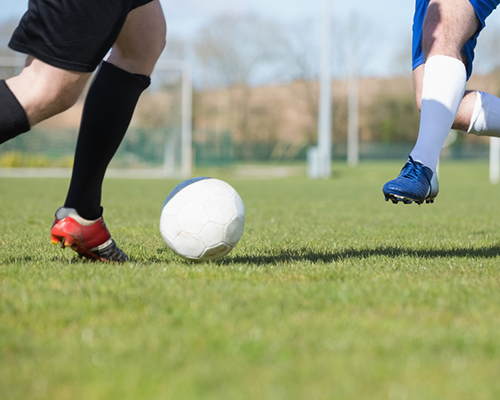From children having a kick about with their grandparents, to Sunday leaguers and professional footballers; football is probably the world’s most popular sport, with millions of people playing it every day.
Like many sports, football can still cause injury, with an overall 30 per cent of all players sustaining an injury at some point.
They have to twist, turn and jump at speed, and can land awkwardly which may result in short term or long term injury.

Warming up
An effective warm-up prior to playing football will reduce your risk of injury in several ways, including:
- Your muscles are more extensible when the tissue temperature has been increased
- Practicing sports specific drills helps to fine tune co-ordination
An excellent reliable and evidence based warm-up is the FIFA’s 11+ programme, which you can access on the internet. We recommend trying it with your teammates for greater fun!
Now that we’re properly warmed up, we’ll move on to talk about three of the most common injuries encountered when playing football and how to minimise the risk of sustaining these injuries.
The three most common injuries
-
Hamstring muscles
The hamstring muscles work over the hip and knee joint. When sprinting while playing football, the hamstring muscles can be stretched beyond their limit which can result in the fibres tearing.
This is referred to as a strain, and depending on the severity, it will be classified as first, second or third degree. The most common hamstring injuries occur during the eccentric phase of muscle contraction. This is when the muscle elongates after kicking or when stretching and reaching to control the ball at high speed.
One of the best ways to reduce your risk of picking up a hamstring strain is to improve your hamstring strength throughout its full range of movement. Three of the best exercises are Nordic Curls, Gym ball Curls and the Arabesque (single leg deadlift).
-
Ankle sprains
An ankle sprain is soft tissue damage (mainly ligaments but also sometimes the joint capsule), around the ankle. Sprains are classified into three grades with the most serious resulting in a complete rupture. As playing football involves sharp twisting and turning manoeuvres, combined with jumping and landing at speed, your ankles are at a high risk of rolling over which may result in a sprain.Two of the best ways to reduce the risk are: proprioceptive training and taping/strapping
Proprioception training is the skill of your body’s ability to maintain alignment and balance, it’s a multifactorial skill, involving more than just balance but also a whole range of your body’s other systems and senses, and it can be trained. Wobble board training is designed to assist re-education of balance and proprioception. You can perform this at home by balancing on one leg on unstable surfaces, and then progress by squatting or moving other parts of your body around and or even by closing your eyes.
Taping or strapping the ankle can help to reduce your risk of getting an ankle strain, especially if you have had one previously. Although the mechanical effects are temporary, it is widely believed to have neurological and psychological effects. Our physiotherapists can teach you how to effectively tape your ankle.
-
ACL (anterior cruciate ligament) rupture
The ACL lies deep within the knee joint and connects the thigh bone to the shin bone. It has an intimate relationship with the hamstrings muscles to prevent excessive forward movement of the shin and rotation of the knee.The ACL can be injured in several different ways whilst playing football, most commonly by landing from a jump onto a bent knee then twisting, or landing on a knee that is over extended. Finally, direct trauma to the knee from another player can also damage the ACL.
A complete rupture may result in a lengthy period of rehabilitation and is likely to require surgery, especially if you want to return to playing football. Our physiotherapists have lots of experience rehabbing patients following ACL tears and reconstructions and can help you to achieve this.
There is evidence to suggest that if you have more control over your knee into valgus (inwards) direction then you are less likely to suffer an ACL injury. So, it is very important that any gluteal (buttock) and core (trunk/abdominal) weakness is tested for and addressed.
For some great glute strengthening exercises, we like the Band walks. For core and trunk strengthening, plank and side plank exercises are excellent. These exercises are a great starting point and easy to perform even without attending a gym.
Players should also regularly practice plyometric exercises (double or single leg jumps) and balance drills to improve neuromuscular conditioning and reaction time.
Equipment that can help
Don't forget that The London Clinic has a wide range of state-of-the-art physiotherapy equipment to help you recover from any of these injuries.
Disclaimer
Any views expressed in this article are those of the featured specialist(s) and should not be considered to be the views or official policy of The London Clinic.